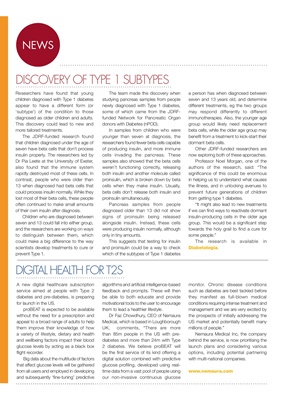
NEWS
DISCOVERY OF TYPE 1 SUBTYPES
Researchers have found that young
children diagnosed with Type 1 diabetes
appear to have a different form (or
'subtype') of the condition to those
diagnosed as older children and adults.
This discovery could lead to new and
more tailored treatments.
The JDRF-funded research found
that children diagnosed under the age of
seven have beta cells that don't process
insulin properly. The researchers led by
Dr Pia Leete at the University of Exeter,
also found that the immune system
rapidly destroyed most of these cells. In
contrast, people who were older than
13 when diagnosed had beta cells that
could process insulin normally. While they
lost most of their beta cells, these people
often continued to make small amounts
of their own insulin after diagnosis.
Children who are diagnosed between
seven and 13 could fall into either group,
and the researchers are working on ways
to distinguish between them, which
could make a big difference to the way
scientists develop treatments to cure or
prevent Type 1.
The team made the discovery when
studying pancreas samples from people
newly diagnosed with Type 1 diabetes,
some of which came from the JDRFfunded Network for Pancreatic
Organ
donors with Diabetes (nPOD).
In samples from children who were
younger than seven at diagnosis, the
researchers found fewer beta cells capable
of producing insulin, and more immune
cells invading the pancreas. These
samples also showed that the beta cells
weren't functioning correctly, releasing
both insulin and another molecule called
proinsulin, which is broken down by beta
cells when they make insulin. Usually,
beta cells don't release both insulin and
proinsulin simultaneously.
Pancreas samples from people
diagnosed older than 13 did not show
signs of proinsulin being released
alongside insulin. Instead, these cells
were producing insulin normally, although
only in tiny amounts.
This suggests that testing for insulin
and proinsulin could be a way to check
which of the subtypes of Type 1 diabetes
a person has when diagnosed between
seven and 13 years old, and determine
different treatments, eg the two groups
may respond differently to different
immunotherapies. Also, the younger age
group would likely need replacement
beta cells, while the older age group may
benefit from a treatment to kick-start their
dormant beta cells.
Other JDRF-funded researchers are
now exploring both of these approaches.
Professor Noel Morgan, one of the
authors of the research, said: "The
significance of this could be enormous
in helping us to understand what causes
the illness, and in unlocking avenues to
prevent future generations of children
from getting type 1 diabetes.
"It might also lead to new treatments
if we can find ways to reactivate dormant
insulin-producing cells in the older age
group. This would be a significant step
towards the holy grail to find a cure for
some people."
The research is available in
Diabetologia.
DIGITAL HEALTH FOR T2S
A new digital healthcare subscription
service aimed at people with Type 2
diabetes and pre-diabetes, is preparing
for launch in the US.
proBEAT is expected to be available
without the need for a prescription and
appeal to a broad range of adults to help
them improve their knowledge of how
a variety of lifestyle, dietary and health
and wellbeing factors impact their blood
glucose levels by acting as a black box
flight recorder.
Big data about the multitude of factors
that affect glucose levels will be gathered
from all users and employed in developing
and subsequently 'fine-tuning' predictive
algorithms and artificial intelligence-based
feedback and prompts. These will then
be able to both educate and provide
motivational tools to the user to encourage
them to lead a healthier lifestyle.
Dr Faz Chowdhury, CEO of Nemaura
Medical, which is based in Loughborough
UK, comments, "There are more
than 85m people in the US with prediabetes and more
than 24m with Type
2 diabetes. We believe proBEAT will
be the first service of its kind offering a
digital solution combined with predictive
glucose profiling, developed using realtime data from
a vast pool of people using
our non-invasive continuous glucose
monitor. Chronic disease conditions
such as diabetes are best tackled before
they manifest as full-blown medical
conditions requiring intense treatment and
management and we are very excited by
the prospects of initially addressing the
US market and potentially benefit many
millions of people."
Nemaura Medical Inc, the company
behind the service, is now prioritising the
launch plans and considering various
options, including potential partnering
with multi-national companies.
www.nemaura.com